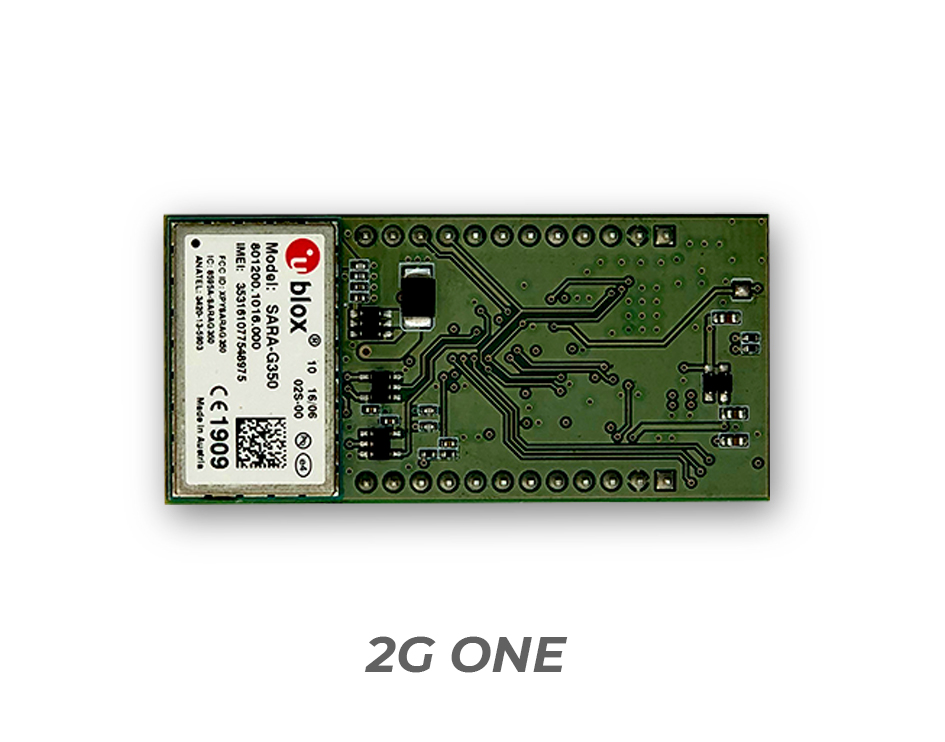2G One¶

Overview¶
This board is based on our successful Autonomo. A proven 32 bits Arduino compatible platform. It has a solar charge controller and runs on a LiPo or permanent battery.
Next we added a GPS module. We chose the Ublox Eva 7M. It’s not only very small, but with it’s assisted GPS feature it can get a fix in just seconds.
We also included a low power Accelerometer/Magnetometer chip. This means we can keep the board in sleep until it moves or has a change in magnetic field. This is crucial for developing low power devices.
Say you want to develop a bicycle tracker. You would like know the position of the bike, but only when it has moved. So keep the device in deep sleep until you detect motion. If the motion continues for a while, the bicycle may have changed position so you only then switch on the GPS to get a new reading and send this new location over the GPRS/2G network. This way you make most efficient use of you battery capacity by only using the GPS when really needed.
The Magnetometer extends the range of possibilities. You could now use the board to develop a parking sensor (fit the device in the street, if a car is parked this changes the magnetic field). Or you can mount it to a fence and use the compass direction to determine if the gate is open or not.
The board is so small (57×25 mm) you can fit it inside almost anything. To ease the development we have fitted two rows of headers so you can use it on a breadboard. Why? Well it has 14 free I/O lines that you can use for your own purpose. Whether you want to build a weather station, control street lights or get a signal when you have received (snail) mail. It’s all possible with the SODAQ ONE.
The SODAQ ONE 2G is discontinued.
Getting Started¶
Follow the getting started guide to verify you use the correct URL and update your boardfiles to the latest version.
Features¶
| Microcontroller | ATSAMD21G18, 32-Bit ARM Cortex M0+ |
| Compatibility | Arduino M0 Compatible |
| Size | 57 x 25 mm |
| Operating Voltage | 3.3V |
| I/O Pins | 14, All can be used for digital and analog with PWM, UART, SPI and TWI (I2C) |
| Analog Output Pin | 10-bit DAC |
| External Interrupts | Available on all pins |
| DC Current per I/O pin | 7 mA |
| Flash Memory | 256 KB |
| SRAM | 32KB |
| EEPROM | Up to 16KB by emulation |
| Clock Speed | 48 MHz |
| Power | 5V USB power and/or 3.7 LiPo battery |
| Charging | Solar charge controller, up to 500mA charge current |
| LED | RGB LED |
| GPRS/2G | uBlox SARA-G350 |
| GPS | uBlox EVA 7M |
| Accelerometer/Magneto | LSM303D |
| USB | MicroUSB Port |
Pinout¶

Pin definitions¶
Now that you’re using the SODAQ LoRaONE board files, you’ll be able to use our handy pin definitions. Let’s say you want to use the red LED, but you forgot that pesky pin number, you can just address the led with LED_RED inside your Arduino IDE. Our pin definitions allow you to address by name instead of pin number.
Here are all the pin definitions for the LoRaONE:
| Pin description | Pin number |
| Red LED | D14 |
| Green LED | D15 |
| Blue LED | D16 |
| Power Enable | D22 |
| GPS Enable | D18 |
| External Switch Sense | D23 |
| Push Button | D19 |
| GPS Timepulse | D17 |
| VCC 2G uBlox | ENABLE_2G |